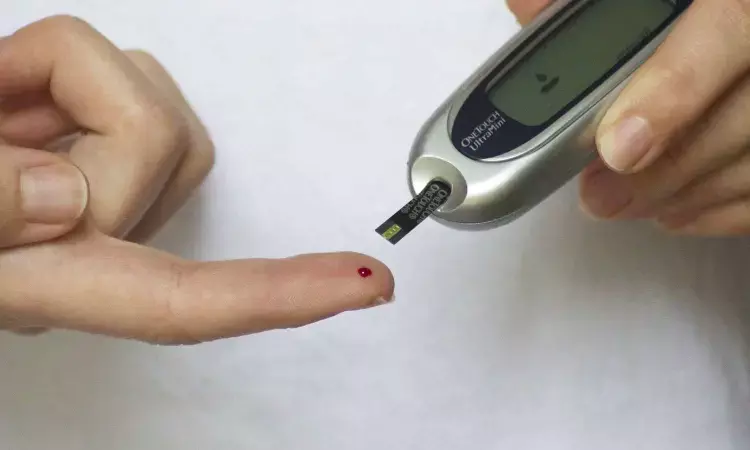- Home
- Medical news & Guidelines
- Anesthesiology
- Cardiology and CTVS
- Critical Care
- Dentistry
- Dermatology
- Diabetes and Endocrinology
- ENT
- Gastroenterology
- Medicine
- Nephrology
- Neurology
- Obstretics-Gynaecology
- Oncology
- Ophthalmology
- Orthopaedics
- Pediatrics-Neonatology
- Psychiatry
- Pulmonology
- Radiology
- Surgery
- Urology
- Laboratory Medicine
- Diet
- Nursing
- Paramedical
- Physiotherapy
- Health news
- Fact Check
- Bone Health Fact Check
- Brain Health Fact Check
- Cancer Related Fact Check
- Child Care Fact Check
- Dental and oral health fact check
- Diabetes and metabolic health fact check
- Diet and Nutrition Fact Check
- Eye and ENT Care Fact Check
- Fitness fact check
- Gut health fact check
- Heart health fact check
- Kidney health fact check
- Medical education fact check
- Men's health fact check
- Respiratory fact check
- Skin and hair care fact check
- Vaccine and Immunization fact check
- Women's health fact check
- AYUSH
- State News
- Andaman and Nicobar Islands
- Andhra Pradesh
- Arunachal Pradesh
- Assam
- Bihar
- Chandigarh
- Chattisgarh
- Dadra and Nagar Haveli
- Daman and Diu
- Delhi
- Goa
- Gujarat
- Haryana
- Himachal Pradesh
- Jammu & Kashmir
- Jharkhand
- Karnataka
- Kerala
- Ladakh
- Lakshadweep
- Madhya Pradesh
- Maharashtra
- Manipur
- Meghalaya
- Mizoram
- Nagaland
- Odisha
- Puducherry
- Punjab
- Rajasthan
- Sikkim
- Tamil Nadu
- Telangana
- Tripura
- Uttar Pradesh
- Uttrakhand
- West Bengal
- Medical Education
- Industry
Tirzepatide has unique activity to stimulate insulin secretion

Tirzepatide, a drug approved for diabetes and on the fast track for approval as a weight loss therapy, works through a unique ability to activate two different mechanisms the body uses to control insulin secretion and energy balance, Duke Health researchers report.
The finding, reported June 5 in the journal Nature Metabolism, is the first study to use cells from human donors to demonstrate how tirzepatide stimulates insulin secretion, an important action utilized by this drug to lower blood glucose in patients with type 2 diabetes.
“Understanding the potential of drugs that target more than one mechanism opens a whole new world of discovery for better weight-loss and diabetes drugs,” said senior author Jonathan Campbell, Ph.D., associate professor in the departments of Medicine and Pharmacology and Cancer Biology at Duke University School of Medicine, and member of the Duke Molecular Physiology Institute.
Tirzepatide is marketed under the brand name Mounjaro. It and similar therapies are known as receptor agonists, meaning they bind to a certain receptor in cells, triggering a specific action for that cell to carry out. There is a long history of diabetes therapies that target the glucagon-like peptide-1 (GLP-1) receptor.
For people with type 2 diabetes, these GLP-1-based drugs restore insulin production and lower blood glucose. The therapies also make people who take the medication feel full longer and reduce appetite, which leads to people dropping weight over time. This has made GLP-1 based therapies very attractive for the treatment of diabetes and obesity.
Tirzepatide is unique in this class of drugs, in that it targets not only the GLP-1 receptor, but also an additional receptor for the glucose-dependent insulinotropic polypeptide (GIP). In theory, this additional receptor gives the drug a broader range of activity inside the body.
However, the GIP receptor has historically been overlooked as a target for metabolic disease, with some people even proposing to block this receptor rather than activate it. This history fed speculation from some in the field that the activity of tirzepatide at the GIP receptor was not important, inferring that tirzepatide worked as a “super” GLP-1 receptor agonist.
Campbell and colleagues originally expected to find that most of the activity of tirzepatide was at the GLP-1 receptor. But in experiments using donated cadaver islet cells, they found that it was the GIP receptor that was indispensable for the insulin secretion that occurred when the islets were stimulated with tirzepatide.
They also found that tirzepatide stimulated the production of glucagon, another islet hormone. GIP stimulates glucagon secretion, while GLP-1 inhibits it. The finding that tirzepatide stimulates glucagon secretion is more evidence that this drug has important activity at the GIP receptor.
“Because our work shows that tirzepatide is a true multi-receptor agonist, and not just a super-GLP-1 receptor agonist, it validates the potential of using single molecules with activity at more than one receptor as a viable approach to treat metabolic disease,” Campbell said. “Extending these studies to the cell types that control appetite and body weight should be an important and exciting future direction.”
Reference:
El, K., Douros, J.D., Willard, F.S. et al. The incretin co-agonist tirzepatide requires GIPR for hormone secretion from human islets. Nat Metab (2023). https://doi.org/10.1038/s42255-023-00811-0.
Dr Kamal Kant Kohli-MBBS, DTCD- a chest specialist with more than 30 years of practice and a flair for writing clinical articles, Dr Kamal Kant Kohli joined Medical Dialogues as a Chief Editor of Medical News. Besides writing articles, as an editor, he proofreads and verifies all the medical content published on Medical Dialogues including those coming from journals, studies,medical conferences,guidelines etc. Email: drkohli@medicaldialogues.in. Contact no. 011-43720751


